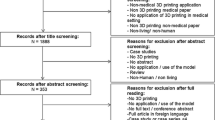Abstract
Background
Posterior instrumentation techniques are commonly employed for cervicothoracic fixation. The pedicles of the upper thoracic vertebrae can typically accommodate larger diameter screws than the subaxial cervical vertebrae. In many construct systems, this requires the use of a tapered rod, which can be technically challenging to place.
Method
Using a three-dimensionally printed biomimetic spine simulator, we illustrate the stepwise process of instrumentation and tapered rod placement across the cervicothoracic junction (CTJ).
Conclusion
Tapered rod systems can augment the biomechanical stability of cervicothoracic constructs. Ease of rod placement across the CTJ hinges upon a systematic method of instrumentation.

Similar content being viewed by others
References
Barrey C, Cotton F, Jund J, Mertens P, Perrin G (2003) Transpedicular screwing of the seventh cervical vertebra: anatomical considerations and surgical technique. Surg Radiol Anat 25:354–360. https://doi.org/10.1007/s00276-003-0163-5
Bayoumi AB, Efe IE, Berk S, Kasper EM, Toktas ZO, Konya D (2018) Posterior rigid instrumentation of C7: surgical considerations and biomechanics at the cervicothoracic junction. A Review of the Literature. World Neurosurg 111:216–226. https://doi.org/10.1016/j.wneu.2017.12.026
Clifton W, Edwards S, Louie C, Dove C, Damon A, Nottmeier E, Pichelmann M (2019) Techniques and tips for freehand placement of C7 pedicle screws with respect to cervicothoracic constructs: 2-dimensional operative video. Oper Neurosurg. https://doi.org/10.1093/ons/opz235
Godzik J, Dalton JF, Martinez-Del-Campo E, Newcomb A, Dominguez F, Reyes PM, Theodore N, Kelly BP, Crawford NR (2018) Biomechanical evaluation of cervicothoracic junction fusion constructs. World neurosurgery. https://doi.org/10.1016/j.wneu.2018.12.040
Heller JG, Carlson GD, Abitbol JJ, Garfin SR (1991) Anatomic comparison of the Roy-Camille and Magerl techniques for screw placement in the lower cervical spine. Spine 16:S552–S557. https://doi.org/10.1097/00007632-199110001-00020
Kulkarni AG, Dhruv AN, Bassi AJ (2015) Posterior cervicothoracic instrumentation: testing the clinical efficacy of tapered rods (dual-diameter rods). J Spinal Disord Tech 28:382–388. https://doi.org/10.1097/bsd.0000000000000133
Radcliff KE, Koyonos L, Clyde C, Sidhu GS, Fickes M, Hilibrand AS, Albert TJ, Vaccaro AR, Rihn JA (2013) What is the incidence of dysphagia after posterior cervical surgery? Spine 38:1082–1088. https://doi.org/10.1097/BRS.0b013e318287ec9f
Wang VY, Chou D (2007) The cervicothoracic junction. Neurosurg Clin N Am 18:365–371. https://doi.org/10.1016/j.nec.2007.02.012
Yu CC, Bajwa NS, Toy JO, Ahn UM, Ahn NU (2014) Pedicle morphometry of upper thoracic vertebrae: an anatomic study of 503 cadaveric specimens. Spine 39:E1201–E1209. https://doi.org/10.1097/brs.0000000000000505
Author information
Authors and Affiliations
Corresponding author
Ethics declarations
Conflict of interest
The authors declare that they have no conflict of interest.
Informed consent
This article does not contain any studies with human participants performed by any of the authors.
Additional information
Publisher’s note
Springer Nature remains neutral with regard to jurisdictional claims in published maps and institutional affiliations.
This article is part of the Topical Collection on Neurosurgical technique evaluation
Electronic supplementary material
Video 1
Preoperative considerations, vital anatomy, and operative technique of tapered rod system for enhancing the biomechanical stability of cervicothoracic constructs. This is demonstrated using a 3D-printed biomimetic simulator (M4V 122553 kb)
Rights and permissions
About this article
Cite this article
Clifton, W., Damon, A. & Pichelmann, M. How I do it: tapered rod placement across the cervicothoracic junction for augmented posterior constructs. Acta Neurochir 161, 2429–2431 (2019). https://doi.org/10.1007/s00701-019-04081-2
Received:
Accepted:
Published:
Issue Date:
DOI: https://doi.org/10.1007/s00701-019-04081-2




